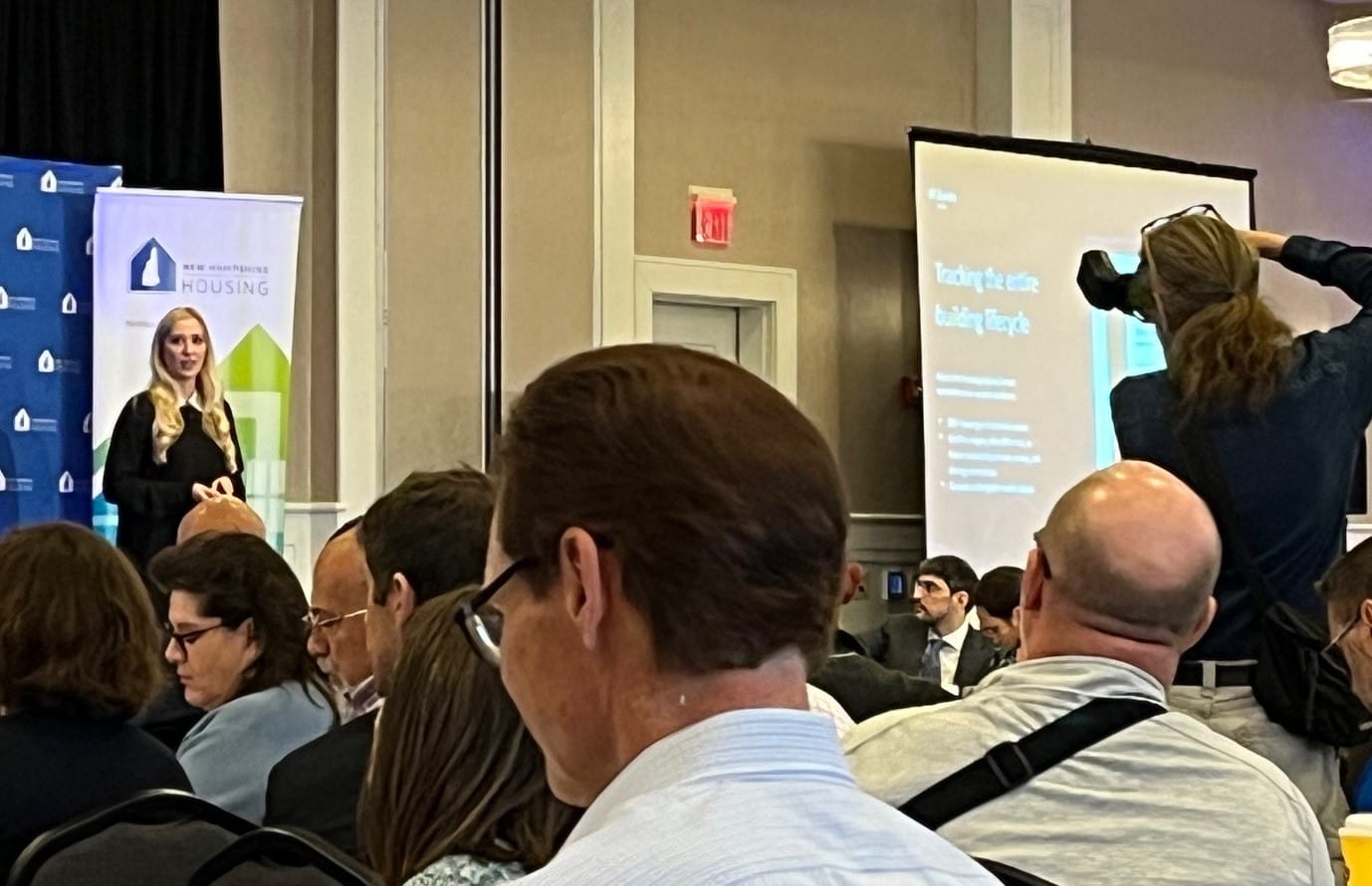New Hampshire housing crisis road runs through small towns as well as the State House
Wolf said she is stunned by the state’s rental unit vacancy rate of 0.8%, which she called “crazy low.” Nationally, the vacancy rate is 5.8% overall, and 5.6% for two-bedroom apartments. “You live here and you are used to this,” she said. But she found the numbers so “bizarre” that when she was revi


PORTSMOUTH, NH – More multi-family housing is needed in in order to solve New Hampshire’s housing crisis, but the road to that is a bumpy one that runs through the boards and offices of the state’s small towns as well as the chambers of the State House.
That was the message to more than 250 housing-industry stakeholders attending New Hampshire Housing’s 2024 Multifamily Housing Conference Friday.
It’s not news that the state needs 60,000 more housing units by 2030 and 90,000 by 2040, according to New Hampshire Housing’s needs assessment, released last year.
“People say that it sounds unachievable, or if it is achievable, we’re going to despoil the landscape that we love,” Rob Dapice, NH Housing executive director, said.
“It is not so,” he added.
That said, achieving those goals – which would ease home prices and skyrocketing rents, as well as making housing available in one of the tightest markets in the country – will take work at every level of government, Friday’s panelists said.
Meanwhile, the housing crisis is having the most critical impact on low-income Granite Staters, who are priced out of even the most basic places to live.
The median gross rent in the state in 2023 was $1,644, a 40% increase over 2018. The median gross rent for a two-unit apartment was $1,764, a 36% increase. And that is if someone can find an apartment to rent. New Hampshire’s rental vacancy rate is 0.8% in general, 0.6% for a two-bedroom apartment, according to Ali Wolf, chief economist for Zonda, a housing market data research company.
Speakers and panelists at the conference stressed that changing policy, educating communities – both residents and local board members – as well as bold moves by the legislature are necessary to turn things around.
Crisis driven by high prices, low vacancy rate
Wolf said she is stunned by the state’s rental unit vacancy rate of 0.8%, which she called “crazy low.” Nationally, the vacancy rate is 5.8% overall, and 5.6% for two-bedroom apartments.
“You live here and you are used to this,” she said. But she found the numbers so “bizarre” that when she was reviewing them in preparation for her talk, she asked Kimberly Byrum, Zonda’s multifamily housing expert, if she was reading them correctly. She was.
Many factors play into the low vacancy rate, including soaring single-family home prices that keep potential buyers in their apartments, as well as lack of inventory.
The obvious solution, she said, is to build more housing. It’s something that’s happening in most markets, but not the way it should be in New Hampshire. Labor shortages and supply chain issues were big barriers to building a few years ago, but developers are finding ways to cope with that. While those are still issues in the state, the biggest challenges now are government services and slow land development.
Wolf said that despite the state’s aging population – New Hampshire has the second-oldest median resident age in the country after Maine – young people will stay in the state or move here if jobs are available. Employment opportunity is the second reason after family or historic ties that people move to New Hampshire.
One key to building more housing is choosing types that are constructed quickly – for instance, garden apartments – and that meet a demand, aren’t competing with similar projects, are visible, and are close to amenities.
The reality is if people seeking to move to the state ask, “Can I rent or can I buy in New Hampshire?” the answer may be neither, she said.
The upside is that “there is a huge market for new rentals.”
Wolf said that incremental changes can help solve the problem, something Dapice also said in his opening remarks.

Aiming for achievable goals
Dapice said that incremental increases, with better planning, will help the state get on track for needed housing.
There are already good signs, including an increase in building permits. Nearly 6,000 were issued in the state in 2022, but there must be an average of around 8,000 a year between 2023 and 2029 to close the 60,000-unit gap.
Positives include another $2.9 million awarded by InvestNH a few months ago for its Housing Opportunity Planning Grant program, which helps cities and towns create local regulations that will help increase housing supply, especially for affordable and workforce housing. The deadline to apply is Sept. 30. The first round of $2.75 million in funding was awarded to 58 municipalities that have used it to hire consultants, study zoning and other regulations, and to update or make recommendations that will allow more housing in their town or city.
InvestNH, funded with $100 million by the Biden administration American Rescue Plan Act, has a capital grant program for multi-family rental development as well as the municipal HOP grants, both programs aimed at promoting construction of affordable housing. It’s administered by the state’s Department of Business and Economic Affairs.
New Hampshire Housing also backed nearly $263 million in mortgages for 875 homebuyers in 2023, 806 of them first-time buyers. The agency’s Assisted Housing Division provided $48 million in rental help to low-income residents.
That said, Dapice noted that it has been “a really frustrating year” in the state legislature.
“So many good ideas have run aground in the last month or so.” He said even if some legislation that will support housing development that’s pending passes “it will still be a session of missed opportunities.”
In the 2025 session, housing advocates will focus on “achievable goals,” he said.
Wins in the legislature this year include additional funding for homeless shelters and passage of bills related to manufactured housing, sprinklers, abutter appeals, and septic standards. Still in play are bills related to parking, vesting, driveways, recovery houses, all of which would help support housing development.
Killed were six funding bills, including for the Affordable Housing Fund, lead mitigation, and the historic housing preservation tax credit, as well as 15 bills that would have increased or supported housing, including those related to ADUs, duplexes, commercial reuse, and the Homenibus bill.
Local control and state role
New Hampshire, along with Maine and Vermont, has done a great job targeting federal ARPA money toward housing, said Nancy Owens, president of Evernorth, a nonprofit organization that finds affordable housing solutions for Maine, New Hampshire and Vermont residents.
But, she said at a panel focusing on financing, more needs to be done on the state level in New Hampshire. Owns cited the defeat of the historic preservation tax credit in the New Hampshire legislature as an example. Maine’s success with the credits has “ignited” development in that state, she said.
Another major piece to developing more housing in New Hampshire is cultural change and advocacy, Owens said.
Dan Pierce, managing director of RBC Community Investment agreed, saying that means advocacy on the federal level as well as the state level.
A panel focused on gaining community support agreed advocacy on the state level is important, particularly when smaller communities that may not have the resources or knowledge to deal with development. But training and advocating in small towns and cities is also key, they said.
Finding ways to turn around opposition to development is an issue at all levels.
Panelists said opponents to housing often cite impact on schools, traffic and local infrastructure, a negative impact on property values and fear of “the other.”
Joe Tamposi, a developer with Tamposi Brothers Holdings, said the questions developers face are always the same, whether the development is proposed for a small town or big city.
“There is always going to be a subset of vocal people who don’t want you to build anything,” Tamposi said.
Tamposi said that when dealing with opposition, being prepared for the questions – “You know what they’re going to be.” – and being consistent with the message, is key.
He said that talking points should include addressing the negative misconceptions to “gain understanding.”
“It’s not going to ruin the town, it’s not going to change the character,” he said. But it’s also about having the information and facts to counter concerns about traffic, schools and infrastructure.
Joanna Kelley, Portsmouth assistant mayor, also said that it’s important to “give people the facts.”
“One thing I try to do is dispel fear that a lot of people have,” she said.
She said one focus in Portsmouth is on owners of two, three, four and five-unit housing, which are usually owned by local people and more affordable. The city is looking at how it can keep those units affordable.
When asked when the right time to engage is, Kelley said “all the time.”
She “has lived in the housing crisis,” including in low-income subsidized housing and as a child in foster care.
“So, when people come up to me and say ‘you’re ruing this town, you’re wasting taxpayer dollars,” she reminds them that she is a taxpayer too, but also has perspective on the housing issue.
But she also said it’s important to have conversations around it, to let people know you’re listening to them, but not necessarily agreeing.
Panelists agreed that people who favor a housing project often don’t speak at board meetings.
“At some point we have to encourage people who support housing [to show up] because people do support housing,” Kelley said.
Judi Barrett, a housing opportunity grant consultant, said it’s important to “find people in the community who don’t hate housing” to speak up at meetings.
She said that it’s not right or fair to ask tenants of low-income or affordable housing to be the advocates at meetings, but those in the community who understand the benefits of housing must speak out.

Inoculation against NIMBYism
Barrett said getting support for housing is also about “training people and myth-busting.”
Panelists agreed that local zoning and planning boards, as well as local governments in general, may need training to understand the issues and be able advocate for housing in the face of pushback that can get ugly.
Max Latona, executive director of the Center for Ethics in Society at Saint Anselm College, said that pushback may not just be NINBYism [“not in my backyard” opposition], but a legitimate concern by an abutter. He said that identifying that concern and addressing it can help. That takes boards fully understanding issues and their roles.
Latona, who is on Manchester’s zoning board of appeals, said that training will help boards “inoculate themselves” from opposition that isn’t legitimate.
Pushback can also come from town boards themselves, panelists said.
Latona said that the fact the town infrastructure can’t handle development is “often used by communities as an excuse to say we can’t support [a project].”
He said that those statements should be looked at more closely to determine if they’re accurate.
Tony Coviello, a member of the Portsmouth Planning Board, who spoke as a member of the audience, said it’s a balancing act for boards to determine what concerns by abutters are legitimate.
A new development might be making life different for abutters “but they don’t own the right to a five-minute commute…you have to make that clear.”
Kelley said that means that boards and town governments must be able to have hard conversations with residents.
“Maybe you’ve had empty land behind you for 100 years,” but you’re not the only one whose concerns the city has to address, for instance. People who weren’t born in the community, but live there and pay taxes, have the same rights as those whose families have been there for generations, Kelley said.
That means finding a moral balance in a city of 23,000 and looking out for unhoused and other housing-challenged residents. After the conversation, “Maybe [opponents] will be walking away not liking you, but they’ll be walking away with more information,” she said.
Tamposi said he has the most success in communities where there is collaboration and “they understand the issues…they’re not stymied by myths and fears.”
Backup from town boards that approach it from that perspective “gives us a lot more force and credibility” when there’s public pushback, he said.
Small communities must step up
Latona said that the state’s biggest cities can’t be the ones to carry the load when it comes to adding housing in New Hampshire. The biggest challenge is smaller municipalities, where not only residents, but town officials, may be opposed to adding housing.
When the Center for Ethical Studies in Society was collecting data for a new layer on water and sewer systems for the New Hampshire Zoning Atlas, some town government officials questioned why they should provide data. What benefit would providing it have for their community?
Latona said that shows that people are connected to their communities, which isn’t necessarily a bad thing. Appealing to that local self-interest to get buy-in is key.
State perspective, Latona said, is important and needs to shift to the understanding by people at the state level that they “are responsible for the whole state, not just individual communities.”
Kelley said that even towns that say they can’t handle it are going to have to face increasing housing development. “We’re never gong to be under one million people again,” she said.
Not finding a way to do it would be a failure of the legislative system and kill off the state’s towns, as have a negative impact state-wide. “Do you want people in your town in 50 years?” she said. The state needs to step up and address the issue with a state-impact perspective.
Barrett also pointed out that the lack of a state income tax is an issue and contributes to the high cost of housing for New Hampshire residents, since property tax revenue becomes so important.
The conference was the second NH Housing held addressing the state’s housing crisis this year. The home ownership conference in March also sold out, and addressed many of the same issues.





